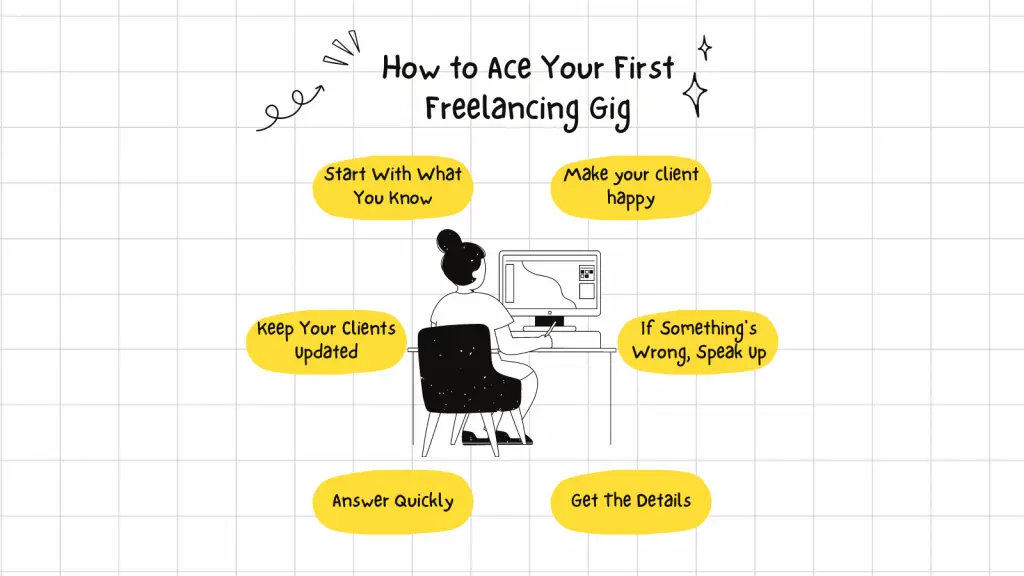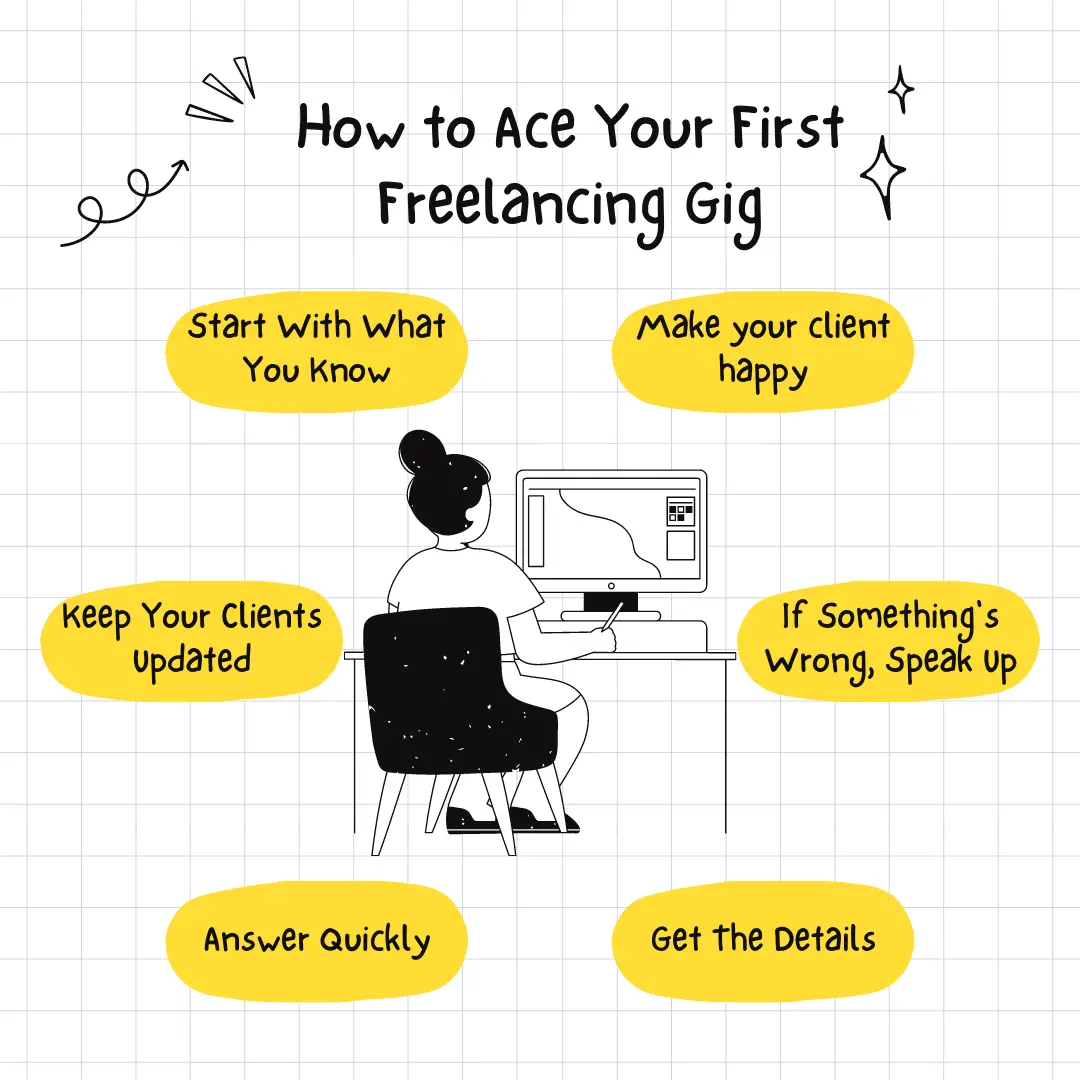
It’s hard to build a freelance career without any experience. How do you get clients when you don’t have a portfolio? It’s almost like the chicken and egg problem, but with freelance projects and experience instead.
There are two main ways to get your first freelancing gig:
Before you start applying for freelance jobs, ask yourself if you can honestly say “Yes!” to both of these questions:
| Takeaways |
|---|
| 1. Prepare thoroughly for your first freelancing gig by understanding the client’s requirements and expectations. |
| 2. Communicate effectively with the client to ensure a clear understanding of project scope, deadlines, and deliverables. |
| 3. Showcase your skills and expertise by presenting a professional portfolio that highlights your relevant work. |
| 4. Deliver high-quality work on time and strive to exceed client expectations to build a positive reputation. |
| 5. Maintain a professional attitude and work ethic throughout the project to establish trust and foster long-term client relationships. |
Are You Able To Work Independently?
Do you have the necessary skills and expertise to complete freelance projects?
If your answer was “No,” then a freelance job is not for you. However, if you are able to positively answer both questions, then it’s time for a self-assessment.
Understanding the essential design contract clauses is crucial for freelancers. Learn more about the important clauses you should know in our comprehensive guide on design contract clauses to protect your interests and ensure a successful freelance career.
Can I devote a lot of time to my clients?
If you answered “No” to either one or both!-of these questions, it’s not a good idea to start freelancing. Just like with any other job, it’s important that you don’t bite off more than you can chew.
Do I have Online Portfolio?
If some of your work has been published online, that makes it easy. You can provide links to the sites where your work has appeared as proof that you’re capable of producing good work. But even if your writing or other work hasn’t been published yet, you can still create a portfolio.
Start by creating a blog to host your portfolio. You could also use social media like Pinterest or Instagram to show off the best examples of your work. If it’s not possible to show images of your projects publicly, consider putting together an offline portfolio on paper or in a PDF document that you can email directly to clients.
When you’ve got some samples ready, look for freelance jobs that match up with what you’ve produced so far in your portfolio. For example, if you’ve written about parenting for several years, apply for parenting-related gigs on sites like
Here are some tips for making sure you get and keep those first few freelance jobs:
“Looking to kick-start your freelancing career? Check out our actionable tips in the article ‘12 Tips to Kick-Start Your Freelancing Career in Less Than a Month‘ and discover effective strategies to accelerate your progress and achieve success as a freelancer.
1. Start With What You Know
The quickest way to get up and running as a freelancer is by leveraging your existing skills. If you’re working full-time while you freelance in your free time, this means offering services related to your day job. For example, if you’re a marketing manager at a tech company, you could start by offering freelance marketing services to other tech companies or even non-competitors.
If you’re not working full-time, or want to offer services unrelated to your current role, think about the types of projects you’ve worked on in the past and what tasks you enjoyed doing most. Then look for freelance jobs related to those skills and experiences.
2. Go Out Of Your Way To Make The Client Happy
If you’re new to freelancing, then you probably won’t have a big portfolio or resume to show for yourself. So go above and beyond to prove that clients can trust you. Deliver finished work before the deadline and make any requested changes promptly.
3. Keep Your Clients Updated
If your client isn’t aware of what’s going on, they might assume the worst and wonder if you’ve forgotten about them completely. By sending regular updates, you’ll keep them in the loop and build trust in the process.
4. If Something’s Wrong, Speak Up
You can’t fix problems if your client doesn’t know about them. If you don’t have all the information you need or are having trouble figuring out a task, let your client know so they can help get things back on track.
5. Answer Quickly
A client can’t hire you if they can’t reach you. If someone reaches out about a job, make sure to respond as soon as possible with details about how and when to contact you, specific availability, and any other information needed to set up an initial discussion.
Freelancing offers a wide range of job opportunities. Explore the various types of freelance jobs and the opportunities they present in our detailed article on the different types of freelance jobs, and find the right path that aligns with your skills and interests.
6. Get The Details
The first thing to do with any new client is asking for details about the project — what exactly do they need? What timeline do they have in mind? How should the final product look? Make sure to get all this information upfront so there are no surprises once the project starts.
Ask questions until you understand everything clearly. This is especially important if your client has a lot of specific requirements — it’s better to ask too many questions than not enough!
7. Follow All Instructions
When you’re freelancing, your clients will generally provide detailed instructions on what they expect from you. Read these carefully, and follow them exactly. There’s nothing more frustrating than having to go back and ask for revisions due to something that could have been avoided with a little extra attention at the start. Freelancers who make revisions easy are the ones who will get asked back again and again.
8. Set Expectations
On that note, it’s important to set expectations early on with both the client and yourself. If a project seems like one that will take longer than expected or require more work
9. Give Yourself A Deadline
You don’t have to do this for every project, but it’s a good practice to set a completion date for that first assignment and stick to it. Nothing is worse than missing a deadline, so give yourself enough time to do the work and then finish early.
10. Reasonable Prices
Set reasonable prices and be willing to negotiate in order to get your first few jobs. It’s better to take a few low-paying jobs at first than it is to wait around for the high-paying jobs that may never come.
Learn from the mistakes of experienced freelancers to avoid common pitfalls. Our article on ‘10 Mistakes I Made Freelancing as a Designer and How You Can Avoid Them‘ provides valuable insights and practical advice to help you navigate your freelance journey successfully.
11. Always Deliver Quality Work
No matter how inexperienced you are or what kind of work your client needs from you. If any part of your work isn’t good enough, then redo it until it is perfect before submitting it to your client or asking them for feedback on it.
Be willing to go above and beyond in order to satisfy clients’ requests so that they will be more likely to recommend you to others or give you repeat business
Building a successful freelancing career requires treating it like a business. Learn why freelancing should be treated as a business and discover valuable insights in our article on Is Freelancing a Business? Here’s Why You Should Treat It Like One.
Final Thoughts
After reading through this post, you should have a pretty good idea of how to get the ball rolling on your first freelance job. First and foremost, make sure your portfolio is ready and waiting if you’re hoping to land a client. You can also use our list of sites as a jumping-off point while you build your portfolio. And, in the meantime, don’t be afraid to contact potential clients with some photos of your work.
Further Reading
Here are some additional resources that you may find helpful:
6 Ways to Get Noticed, Book Your First Gig, and Work as a Freelancer: Discover effective strategies to stand out, secure your first freelancing gig, and thrive in the freelance industry.
First Freelance Developer Gig: How to Get It and What to Expect: Learn valuable tips and insights on landing your first freelance gig as a developer and understanding what to expect during the process.
How to Start Freelancing with No Experience: If you’re new to freelancing and have no prior experience, this article provides guidance on how to start your freelancing journey and overcome the challenge of lacking experience.
How to Ace Your First Freelancing Gig FAQ
Q. How do I find my first freelancing gig?
A. It can be intimidating at first when you’re trying to find someone who will pay you for your services, but once you land that first gig everything will start falling into place.
Q: How can I make sure my first freelance client is a good one?
A: This is probably the number one question we get from new freelancers. The best thing you can do is to be proactive in building your network and portfolio, so you are ready when the right opportunity arises.
Q. What should I do after I get my first gig?
A. I’ve tried to ask for a lot of advice from people I know who are freelancers and also from people that run businesses. You need to know about the business you’re working with and any potential partners. You want to make sure that you’re on the same page. Get as much information as possible, so you can make an informed decision.
Q. What Should You Charge?
A. This is probably the most difficult part of freelancing, so don’t feel bad if you’re unsure what rates to propose. To determine a fair price, you want to figure out how long it will take you to complete the assignment and divide that into your annual income goal.
For example, if you want to earn $60,000 per year and this project will take 50 hours to complete, you should charge at least $1,200. Remember that in addition to paying yourself for the time spent working on the project, you need to make money for your “downtime” as well — sick days, vacation days, holidays, and leisure time; these are all things freelancers pay themselves for too.
Q. How did you find your first gig?
A. I found my first gig through Upwork (formerly oDesk). In those days, clients would hire based on “hourly pay rate,” so I bid very low to get my first job

Costantine Edward is a digital marketing expert, freelance writer, and entrepreneur who helps people attain financial freedom. I’ve been working in marketing since I was 18 years old and have managed to build a successful career doing what I love.
